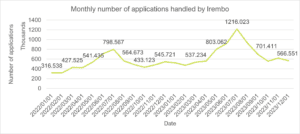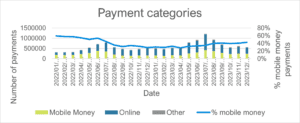Digitisation of government services in Rwanda: Lessons from the data
Digitisation of government services in Rwanda: Lessons from the data
1 October, 2024 •Rwanda has set ambitious goals to transition from an agrarian economy to a knowledge-based one by 2050. This is operationalised through initiatives like the Smart Rwanda Master Plan. The dream is to make Rwanda the digital hub of Africa, and a key focus is the digitisation of government services through the Irembo platform. According to the Rwanda Information Society Authority (RISA), over 50% of government services are now digitised; that is 223 services on the Irembo Gov platform.
Rwandans can now apply online for birth, marriage, and death certificates, renew their healthcare insurance, register for driving licenses, pay traffic fines, and apply for land titles – directly from their devices or with the help of an Irembo agent.
As part of the Rwanda Economy Digitalisation Programme, Cenfri analysed data generated by the Irembo Gov platform to understand the extent of service digitisation and identify areas for improvement. Irembo plays a key role in the Government of Rwanda’s digitisation strategy by providing the technical backbone for government services while also offering assistance to citizens through their agent base and customer service centre.
Growth in online services
Our data analysis highlighted a significant growth in online service usage, with the number of applications rising from 5.9 million in 2022 to 8.4 million in 2023 – a growth rate of 42%. This growth has been driven by key agencies like the Ministry of Local Government (MINALOC), Rwanda National Police (RNP), and the Rwanda Social Security Board (RSSB), which have successfully transitioned many of their services online.
These services are commonly used by a large proportion of the population and online access to these services has not only improved efficiency but also encouraged a sense of trust between the government and the citizens. These services are accessed online through the Irembo Gov website and on USSD by dialling *909#.

Total applications Month-on-Month growth of 40% over the two years
Payments’ digitisation
Irembo has also availed agents to help citizens who are not able to access services online due to different factors such as not owning smart devices or low digital literacy, and these agents can be found at most shopping centres or common areas across the country.
Cash payments are made through banks and agents with agents often using mobile money on behalf of citizens. Other modes of payment allowed on the platform include Mobile Money (Airtel and MTN), Visa, Mastercard, American Express, and payments through Bank of Kigali (BK) and I&M Bank.
However, Mutelle de Sante payments can be made via a SACCO through MobiCash or directly through Irembo, which are both integrated with the RSSB system.
The below graph illustrates the number of payments made through mobile money, online channels and other payment options. It also shows the percentage of payments made through mobile money.
Cash payments are estimated to be between 1 and 6 percent between 2022 and 2024 as stated by Irembo.

Customer care calls have generally decreased
The number of citizens who access services online without the help of an agent has increased from 31% in 2022 to 41% in 2023. This improvement is attributed to simplified application processes, enhanced digital literacy, and continuous awareness campaigns empowering citizens to navigate these platforms. For example, traffic fine payments have disproportionally driven the usage of online services because many drivers do not need to go through an agent.
With faster approval processes, the need for customer care calls has decreased, reflecting an improvement in service delivery. This has been true for services such as Rwanda’s community-based health insurance, Mutuelle de Santé, which saw a 59% increase in user uptake through Irembo from July 2022 to July 2023.
However, the high volume of customer care calls per application suggests that many citizens still seek assistance. Initially, the need for help was more pronounced, but as the application processes became more user-friendly, the frequency of these calls decreased, indicating better self-service capabilities among users. This is evident when we look at the percentage of applications completed by citizens, which rose from 31% in 2022 to 41% in 2023.
Most citizens contact customer care to inquire about application procedures or to check the status of their applications. The primary services inquired about are provided by the Directorate General of Immigration and Emigration (DGIE), RNP, and MINALOC. Differences in application processes across agencies, such as between RSSB (Mutuelle) and RLMUA (land titles), also influence the nature and frequency of these inquiries.
A few obstacles need addressing
Despite the successes, the road to digitisation has not been without obstacles. Affordability of devices, low access to broadband and low digital literacy are some of the key factors affecting full digitisation of services.
Technical issues occasionally disrupt service availability, leading to frustration among users. Application processes vary across services and agencies, with some taking longer to approve than others. For example, the approval time can differ depending on the institution or service, and some services may have slower response rates.
These challenges, though significant, are not insurmountable. The Government of Rwanda is addressing these challenges through several initiatives such as digital literacy campaigns and the deployment of digital ambassadors to assist citizens in using online services, distribution of smartphones and devices and streamlining processes across agencies to make it easier for citizens to apply for services.
What’s next for digital transformation in Rwanda?
To achieve its goals, the government will need to add more efforts to improving user experience across all digital platforms. Simplifying processes, reducing technical issues, and ensuring consistency across agencies to maintain the momentum of digital adoption.
Monitoring the geographical distribution of service users can provide valuable insights into where improvements are needed. By understanding which areas have lower usage rates, the government can target interventions to improve internet coverage, increase digital literacy, or simplify application processes.
